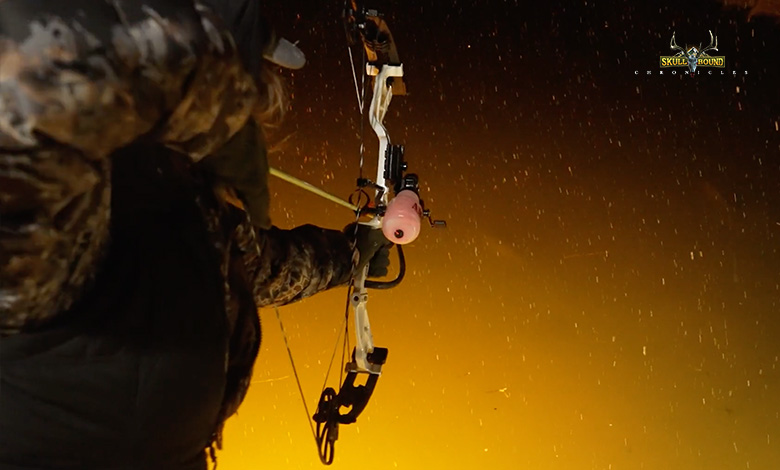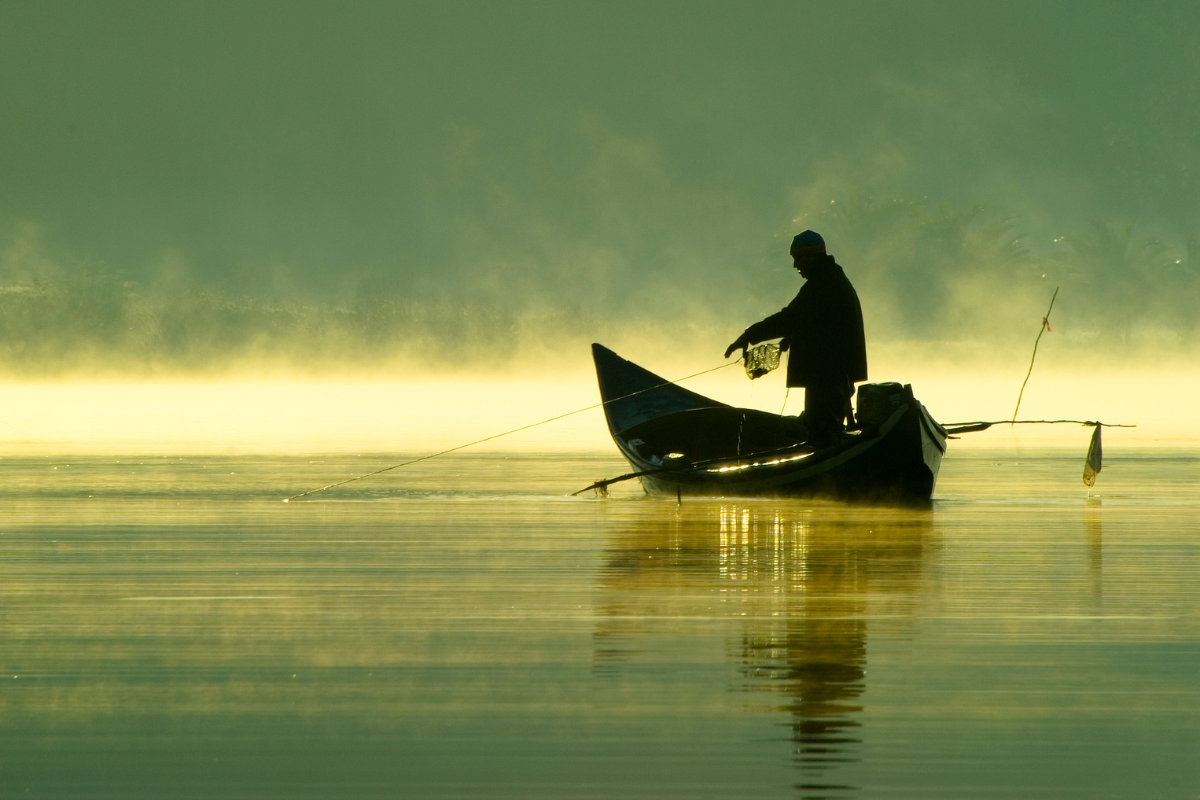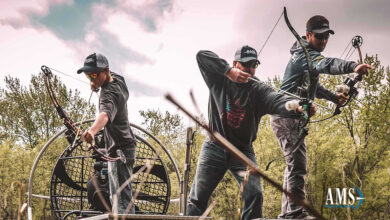What is Bowfishing and How to Get Started?

Ever noticed how the popularity of bowfishing has bounced up steadily in the last decade? With plenty of bowfishing hotspots spread across the country, it is emerging as the perfect fusion sport for outdoor lovers of all ages.
But some of you might be wondering, what exactly is bowfishing?
Bowfishing is the technique of hunting fish with a bow and arrow. That makes it a perfect cross between bowhunting and fishing. The arrow is attached to a line and once your target hits the mark, you reel the fish in.
Almost every type of waterbody is suitable for bowfishing. Even if you have zero fishing experience and lack long-range archery skills, you can participate in the sport.
Types of Bows: Recurve vs. Compound
To start with, you will need some specialized gear for bowfishing. Let’s consider them one by one.
Bows
The two popular options are recurve and compound bows, Each design has its pros and cons. When I started bowfishing, I chose a compound bow as I was told it was great for beginners.
Is it the best option for everyone? Not necessarily. In fact, both types can be fantastic options for enjoying bowfishing.
With compound bows, both the draw weight and draw length are adjustable and the action requires less upper body strength. Accuracy and power delivery are great and you get multiple mounting options. Modern bows also come with advanced cam systems that deliver enough power for deep penetration.
The advantage of a recurve is that it is light and fast. That makes them perfect if you are shooting from a small boat or a kayak. Many a time, while aiming at fast-moving fish, you need to shoot instinctively, and the recurve really shines in these situations. Plus, they are more affordable.
But, while starting, you may need more practice to hit the target with a recurve.
Arrows
When it comes to bowfishing arrow shafts, there are three options- fiberglass, carbon fiber, and composite. Fiberglass is the cheapest option, but the durability of these arrows is limited.
The durability of carbon fiber is fantastic, but they are more expensive. I prefer composite fiberglass arrows with stainless steel or carbon fiber reinforcement that offer the best of both worlds.
For arrow tips, the choice is between gar points and grapple (carp) points. A gar point is good for smaller fish like lake gar that has tough scales. But they will not work on bigger fish like river carp.
A carp point has grapple-like barbs that expand after penetration. The rugged design makes it perfect for deeper penetration and proper retrieval of a species like a Butterfly Carp. They are also good for fishing in punishing waters with a lot of rocks and hard stumps. At times, carp points can be difficult to remove but they are more versatile.
If you prefer nocturnal bowfishing, you can try using an arrow with lighted nocks. These bad boys offer better visibility and are super fun to shoot.
Reels
Modern bowfishing reels can be simple drum reels or spinner-style reels that require a reel seat on the bow. The other popular option is the bottle reel which is super sturdy and takes punishment like a champ.
The real advantage of a drum reel is that it is super affordable. So if you are breaking into bowfishing, they are a good option to start with. That said, each style has its advantages and if you ask me, choosing one over the other is a matter of personal preference.
If you are used to normal fishing reels, the speed at which the line leaves the bowfishing reel will surprise you. For the first time, it dawns on you that a typical arrow travels at speeds between 200 and 350 feet per second.
So, make sure that the line does not get tangled with the reel in any way as that will obstruct the arrow and may cause it to snap back. I’d suggest being cautious and overestimating the line strength as a snap will deprive you of your trophy.
Additional Gear
While you don’t need much gear for bowfishing, a few additional items can make shooting easier. Take a look.
- If you are bowfishing at night, attaching a compact flashlight to your bow can be helpful
- Using shooting gloves will protect your fingers and also keep them warm on cold nights. Or else you can use finger savers to add some cushiony feel.
- Pick waterproof boots that will keep your feet dry
- For better accuracy, you can use a bowfishing laser sight on the bow
- Always wear eye protection while bowfishing. Use polarized sunglasses that cut surface glare and allow you to spot fish better.
Setting Up Your Bowfishing Rig
The prime tool of your bowfishing rig is the bow. Are you planning to use your hunting bow for bowfishing?
Well, it can be done. But my suggestion is, don’t. The combination of water, blood, and fish slime can be corrosive to the bow and its accessories. So, keeping a separate setup for bowfishing is a good idea.
Now, to set up the bow, you will need a few tools. Firstly, you need to set the bow on a press and make sure everything is level before making any adjustments.
Some other tools are Allen keys, tape measure, leveling tools, and a pocket knife. There are a lot of different levels in the market including laser levels. So the leveling methods will vary accordingly. But, if you are doing it for the first time, best to get help from a veteran.
- If you are using finger savers, take the string off the bow at one end and insert it.
- Reconnect the string and fix the bowfishing arrow rest to the bow. Use an arrow level to check if any horizontal, or x-axis, adjustments are needed.
- Now, you need to set up an arrow and use the leveling tool to check the knock and the rest point. Ideally, the knock point should be higher than the rest, just by a fraction. Then again, it depends on your personal preference.
- Check if the arrow is perfectly aligned with the hole at the rest mount, often called the “Berger Hole”. If not, adjust the rest till it does.
- The next thing to check is whether the arrow is lining up perfectly with the string. If there are any left or right offsets, make the necessary adjustments to the rest. Using a laser center shot tool is great for doing it easily. The laser travels along the string and the center of the arrow to ensure that they are level.
- Lastly, mount the reel on the bow. Depending on the reel type, there are various options.
Legal Considerations
While bowfishing is legal in all states, the rules and regulations vary. Check the fishing regulations of the particular state you are heading to. In most cases, all waters are open to bowfishing, unless mentioned otherwise.
You can also try saltwater bowfishing on the eastern seaboard and target species like stingrays. However, some areas have prohibitions on specific species and also on after-hours fishing.
Most states allow bowfishing of non-game, non-native, or invasive fish. These include fish like common carp, bighead carp, catfish, buffalo, and several varieties of gar. Since these fish species are considered rough fish and not targeted by fishermen, bowfishing helps in their population control.
For example, carp is one of the most invasive fish species that can hurt the environment if their population is left unchecked. In fact, environmentalists consider the exploding population of carp a serious concern for the rivers. This is why there are no daily limits on carp. That way, bowfishing can lessen the impact of these species on the environment.
The best times for bowfishing are late spring and summer. As the water temperature warms up, the rough fish species head to shallow waters for spawning. Hardcore bowfishing addicts head to the hot spots in fall and winter also. The advantages are less bowfishing pressure and clearer waters.
Scouting Locations: Where to Do Archery Fishing?
Planning to travel beyond the familiar waters for your next bowfishing adventure? Here are six top options to pick from.
Southern Texas
Southern Texas is a great destination for bowfishing carp, buffalo, and tilapia, but the star attraction is the alligator gar. It is not uncommon for bow fishermen to tussle with a 150-200 pound specimen.
The Choke Canyon Reservoir, the San Antonio River, And the San Marcos River are some popular destinations. Beyond that, you will find lots of action on the saltwater bays in southern Texas.
Mississippi River
The Old Man River is one of the top destinations for bowfishing. While it is a year-round activity, summer is the most exciting period, especially for nighttime bowfishing. Carp, gar, catfish, and buffalo are the common options. Even if the water is brackish, you can target species like the black drum, Atlantic rays, mullet, and the flounder.
With so many reservoirs, backwaters, and freshwater creeks around, you will be spoilt for choices. Each waterbody has a specific characteristic and you need to adapt your techniques accordingly. If you want to hone your bowfishing skills head towards the Mississippi.
Lake Michigan
Even though there are numerous great bowfishing spots around Lake Michigan, I enjoy shooting fish the most while wading through some of the knee-deep marshes of the lakeshore.
There are shallows with crystal waters where carp is found in large quantities. The harbors and bays around the south shore also offer excellent action. Besides, the Great Lakes Bowfishing Championship is held on Saginaw Bay, each year.
Florida’s Nature Coast
Florida has a solid reputation as a top bowfishing destination and the area around Crystal River and Homosassa offers fantastic diversity. The Crystal River is one of the best clearwater bowfishing destinations you will find. Besides, the natural beauty in the Homosassa Springs Wildlife State Park is a big plus. This region is great for bowfishing the hard-fighting tilapia, gar, and catfish.
St. Lawrence River
The huge schools of carp in the St. Lawrence River make it a paradise for carp bowfishing. The common species found here are common carp, suckers, and drums. Some of the monster carp can exceed the 40-pound mark and are found around the boat docks.

Techniques for Successful Bowfishing
Before discussing the techniques, let’s answer the common question about night vs day bowfishing.
Most veterans prefer night bow fishing as the water is colder and fish rise closer to the surface. Species like carp are easier to shoot during the night. Besides, you won’t get scorched by the summer sun. That said, overlooking bowfishing opportunities during the day will be a mistake,
Unlike night bowfishing, you do not need a boat with a lot of lighting for daytime action. In my experience, bowfishing during the day provides a better sense of hunting as you can get close and stalk fish in the shallows. Also, you will find less competition during the day.
Bowfishing Technique
The two popular techniques for bowfishing are stalking and ambushing. Both options work great, but if you ask me, stalking is more fun while fishing alone.
While stalking, you need to approach the fish slowly, and quietly and it is best to use some sort of camouflage. With time, you will learn how close you can get to a fish before releasing the arrow. Frankly, I had my share of embarrassing moments while stalking fish. The process has a learning curve and takes practice.
The other option is to wait silently on a rock on the edge of a shallow bar and look out for fish movements. Chances are, a gar will move around looking for minnows and you will get to nail it from the ambush spot. During the breeding season, spots along steep banks are great for spotting carp activity.
Practical Bowfishing Tips and Tricks
Here are a few quick bowfishing tips that will help separate the men from the boys.
- Whether you are aiming at moving or stationary targets, it is important to know your distance limit. Choose your shots wisely by staying within the limit and your hit percentage will rise. And remember that stealth is your best friend.
- No matter the method of bowfishing or the type of gear you use, the only way to get better is by practicing.
- Make sure to identify the fish before you shoot to ensure that you do not end up shooting a game fish.
- While scouting a new location, look through the contour or topographic maps of the water body you are heading to. Look for deep pockets and drop-offs in the shallow beds to increase your chances.
- Carry the necessary permits or licenses and adhere to the local regulations and size limits.
- Boating a bathtub-sized fish is almost impossible for a single person. With such attempts, the chances of going overboard are high. Allow the fish to exhaust itself. Then tie it to the boat and shoot a few more arrows to kill it off.
- Do not dump the fish you catch on the docks or around the waterbody. Make sure to dispose of them in the right way.
- After each trip, clean your gear without using any harsh chemicals. Always store the bow in a clean and dry place.
Final Thoughts
Without a doubt, bowfishing is one of the most exciting, and addictive forms of outdoor activity. If you are willing to pursue a new outdoor sport, bowfishing is a fantastic option you can try next. In time, you will have some super fun stories to share with your family and friends.
Remember, even if you are aiming for rough fish, it is important to hunt responsibly. Do not take more fish than you can consume or dispose of in the right manner.
It is time to set up the bow and hit the water.


